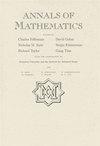Grassmann图中的伪随机集具有接近完美的展开性
IF 5.7
1区 数学
Q1 MATHEMATICS
引用次数: 0
摘要
证明了Grassmann图中的伪随机集具有近完美展开性。这完成了2美元到2美元游戏猜想的证明(尽管不完全)。这一新结果的一些含义是改进了最小顶点覆盖的硬度结果,改进了Dinur和Safra [Ann]的工作。的数学。${\bf 162}$(2005), 439—485],以及Unique-Games的新硬度差距。格拉斯曼图${\sf Gr}_{\sf{global}}$包含诱导子图${\sf Gr}_{\sf{local}}$,这些子图本身与低阶格拉斯曼图同构。如果一个集合在所有子图${\sf Gr}_{\sf{local}}$内的密度为$o(1)$,且这些子图${\sf Gr}_{\sf{global}}$的阶数低于${\sf Gr}_{\sf{global}}$的阶数为$o(1)$,则该集合称为伪随机。我们证明了伪随机集具有展开式$1-o(1)$,极大地推广了Dinur和Kindler前人的成果和技术。本文章由计算机程序翻译,如有差异,请以英文原文为准。
Pseudorandom sets in Grassmann graph have near-perfect expansion
We prove that pseudorandom sets in Grassmann graph have near-perfect expansion. This completes the proof of the $2$-to-$2$ Games Conjecture (albeit with imperfect completeness). Some implications of this new result are improved hardness results for Minimum Vertex Cover, improving on the work of Dinur and Safra [Ann. of Math. ${\bf 162}$ (2005), 439--485], and new hardness gaps for Unique-Games. The Grassmann graph ${\sf Gr}_{\sf{global}}$ contains induced subgraphs ${\sf Gr}_{\sf{local}}$ that are themselves isomorphic to Grassmann graphs of lower orders. A set is called pseudorandom if its density is $o(1)$ inside all subgraphs ${\sf Gr}_{\sf{local}}$ whose order is $O(1)$ lower than that of ${\sf Gr}_{\sf{global}}$. We prove that pseudorandom sets have expansion $1-o(1)$, greatly extending the results and techniques of a previous work of the authors with Dinur and Kindler.
求助全文
通过发布文献求助,成功后即可免费获取论文全文。
去求助
来源期刊

Annals of Mathematics
数学-数学
CiteScore
9.10
自引率
2.00%
发文量
29
审稿时长
12 months
期刊介绍:
The Annals of Mathematics is published bimonthly by the Department of Mathematics at Princeton University with the cooperation of the Institute for Advanced Study. Founded in 1884 by Ormond Stone of the University of Virginia, the journal was transferred in 1899 to Harvard University, and in 1911 to Princeton University. Since 1933, the Annals has been edited jointly by Princeton University and the Institute for Advanced Study.
 求助内容:
求助内容: 应助结果提醒方式:
应助结果提醒方式:


